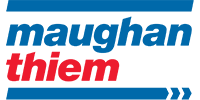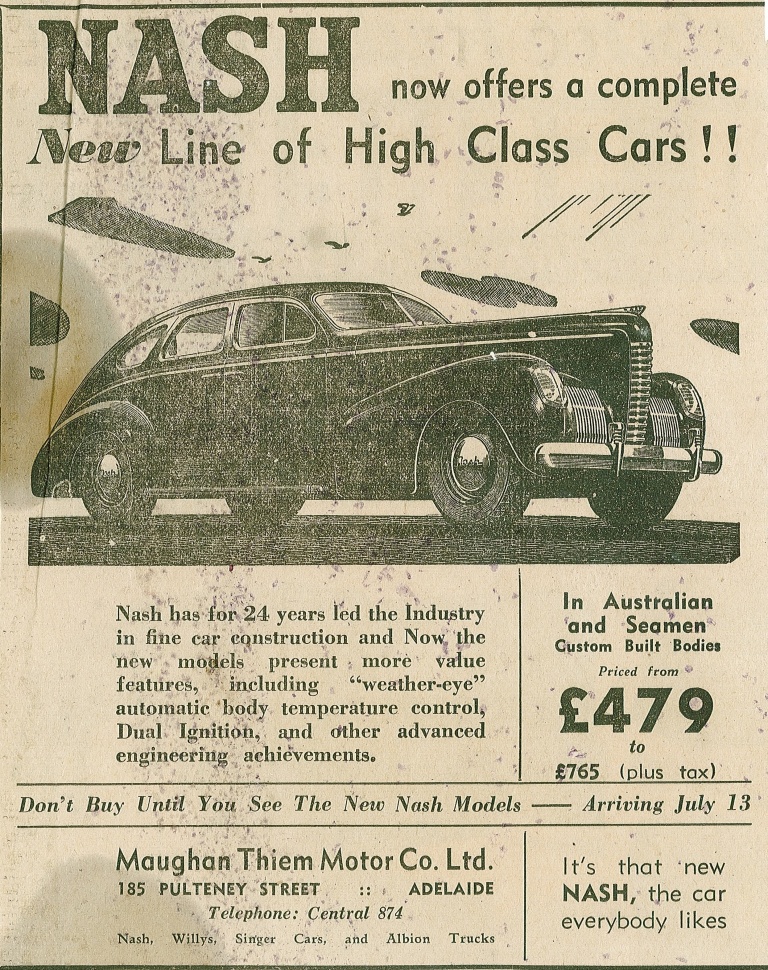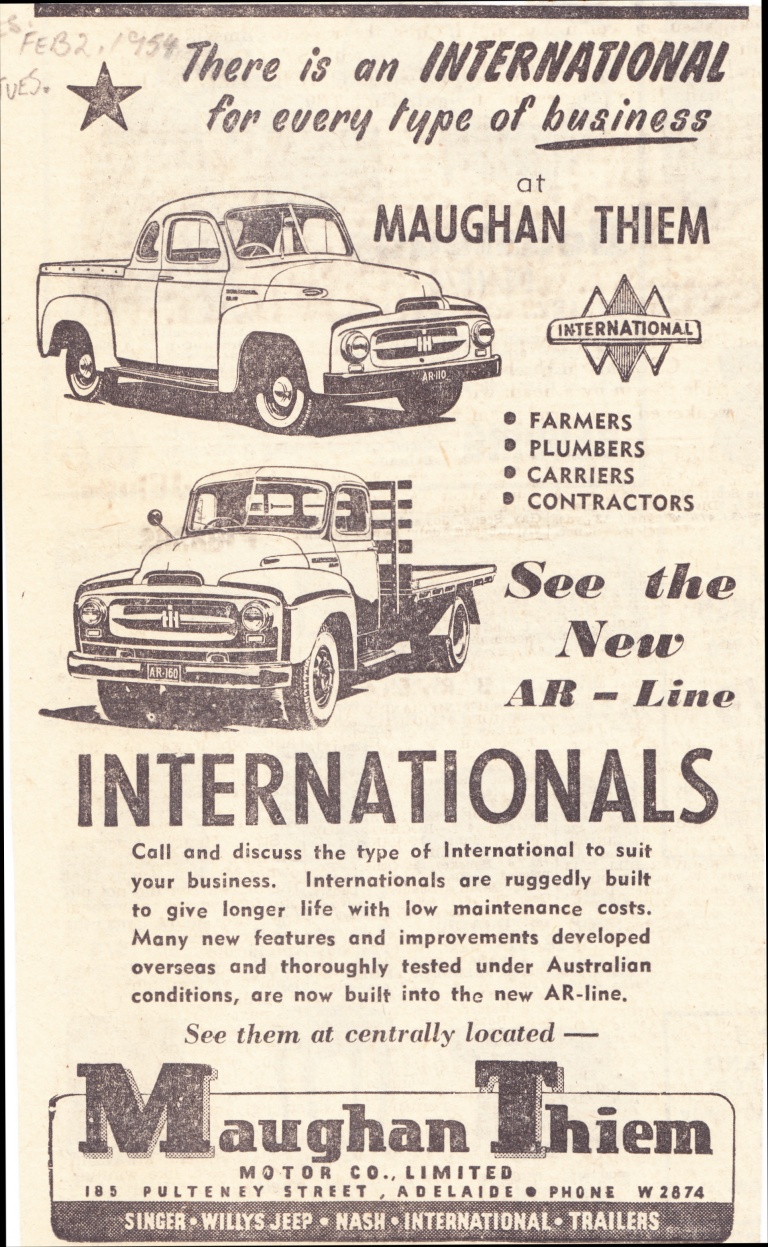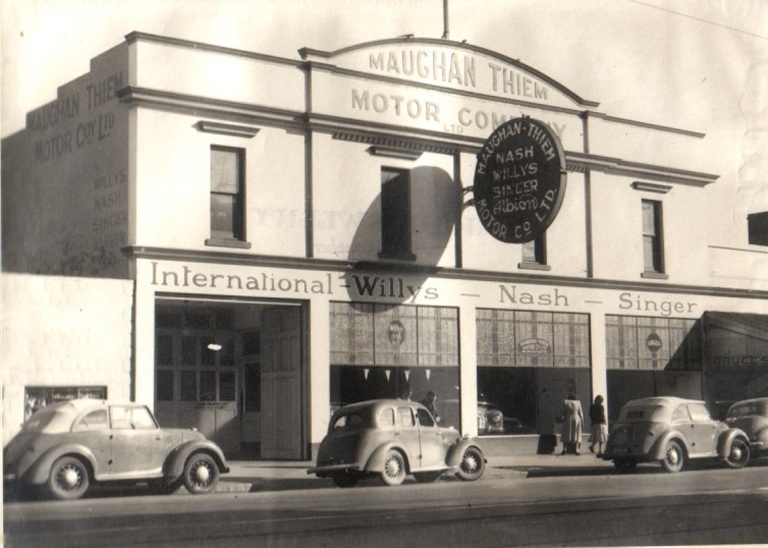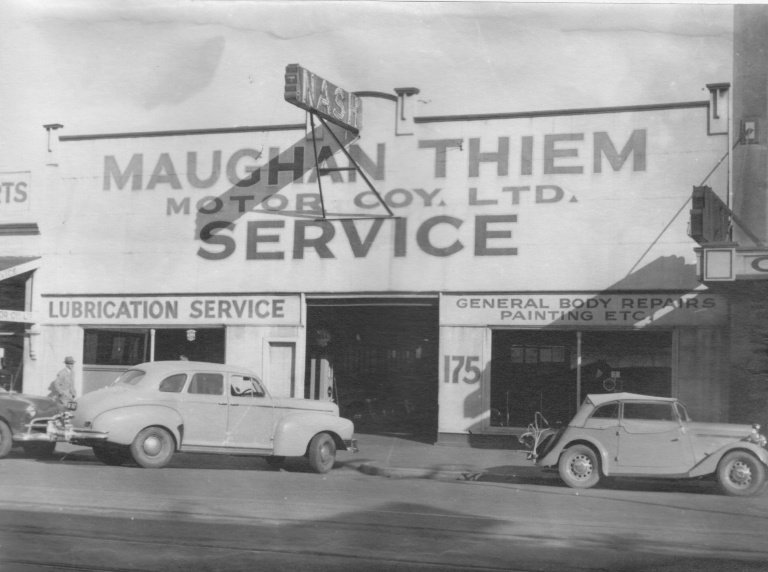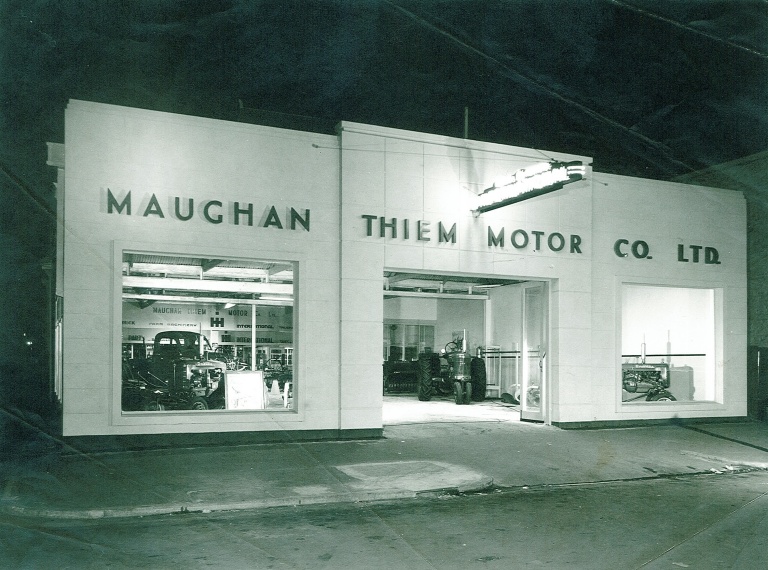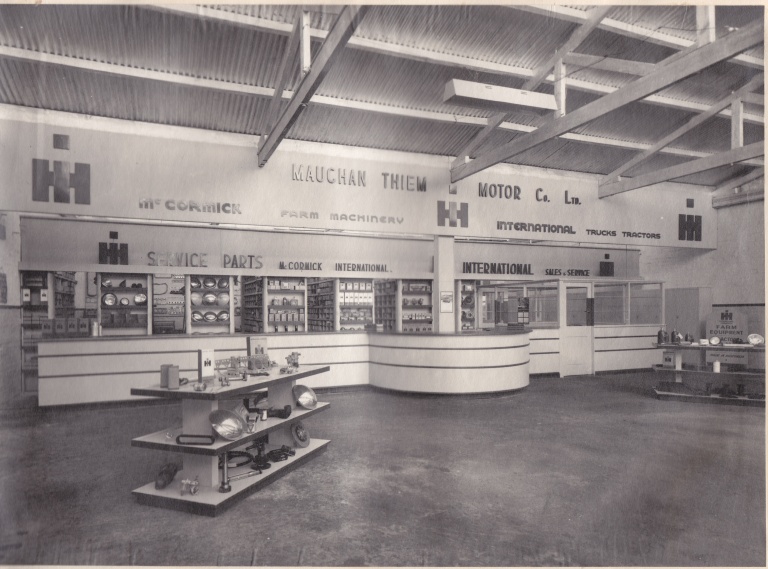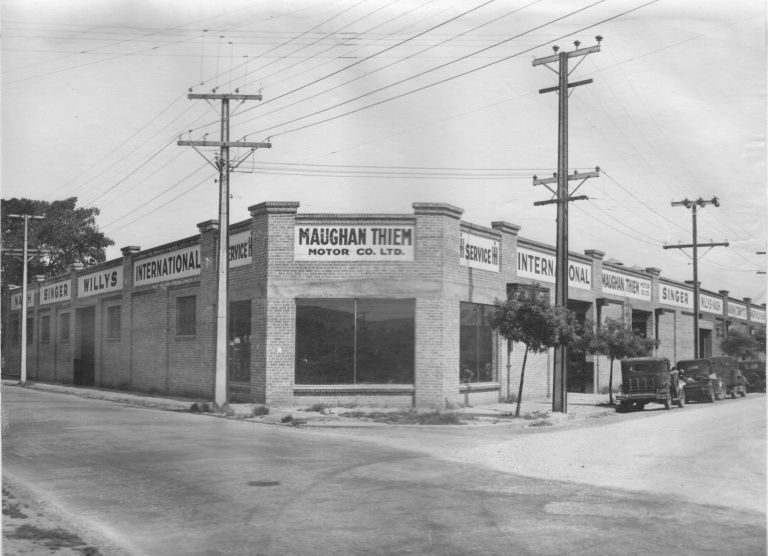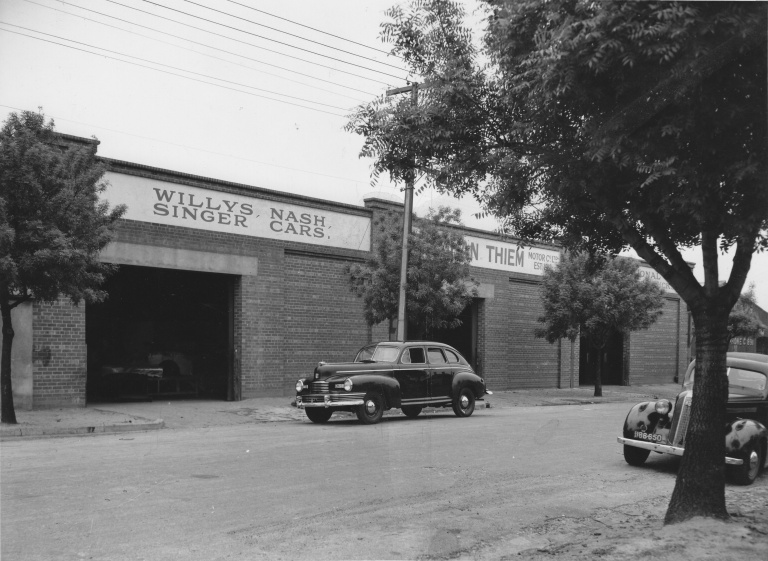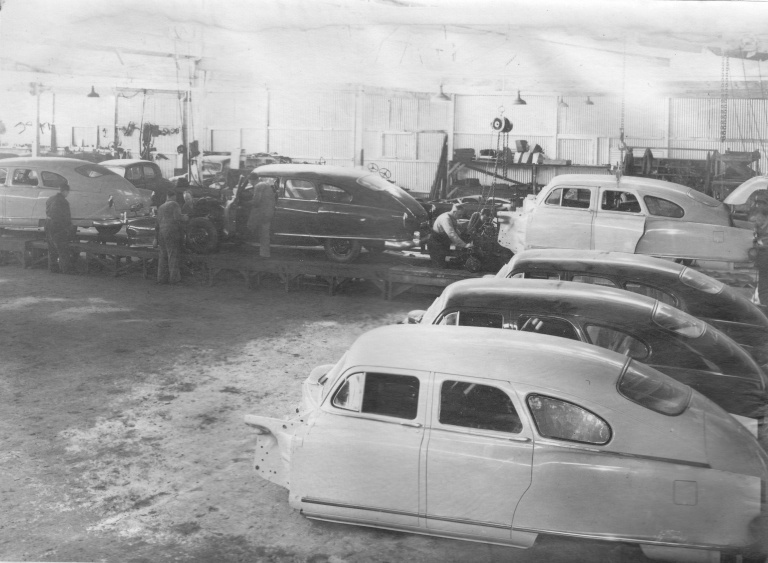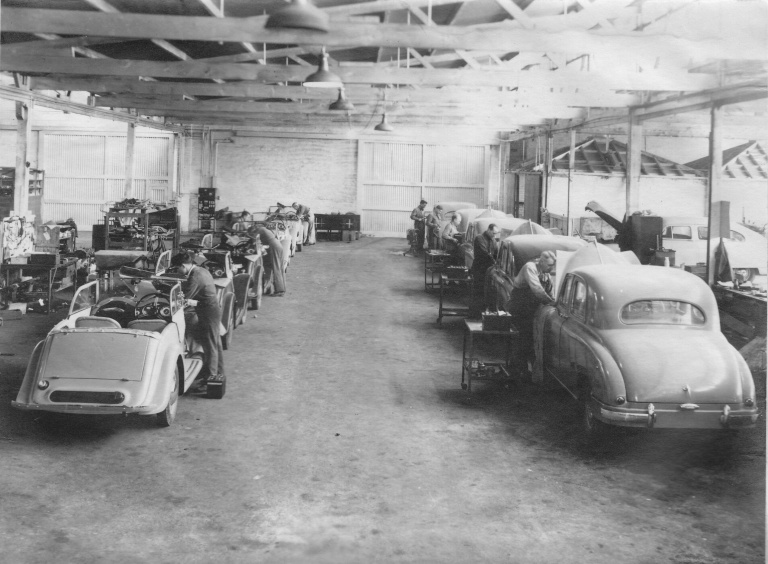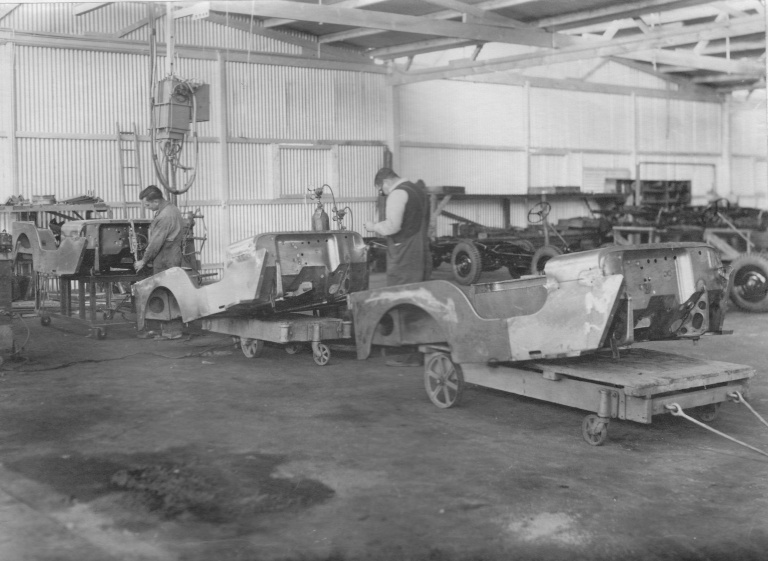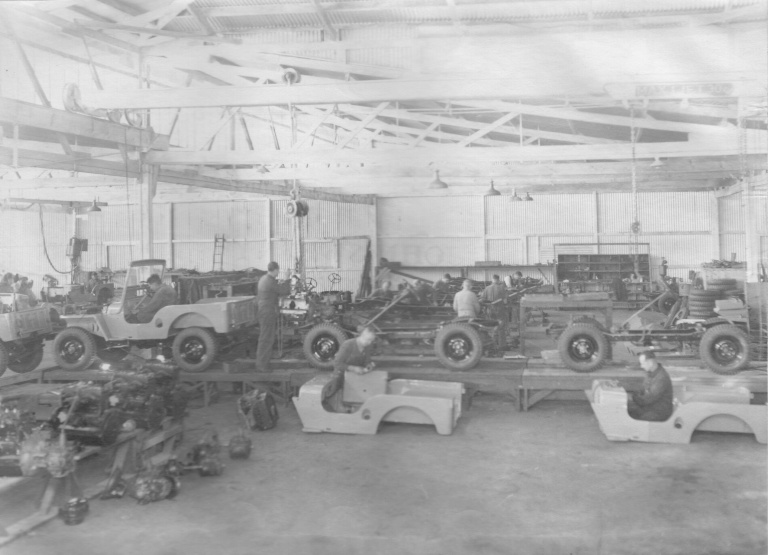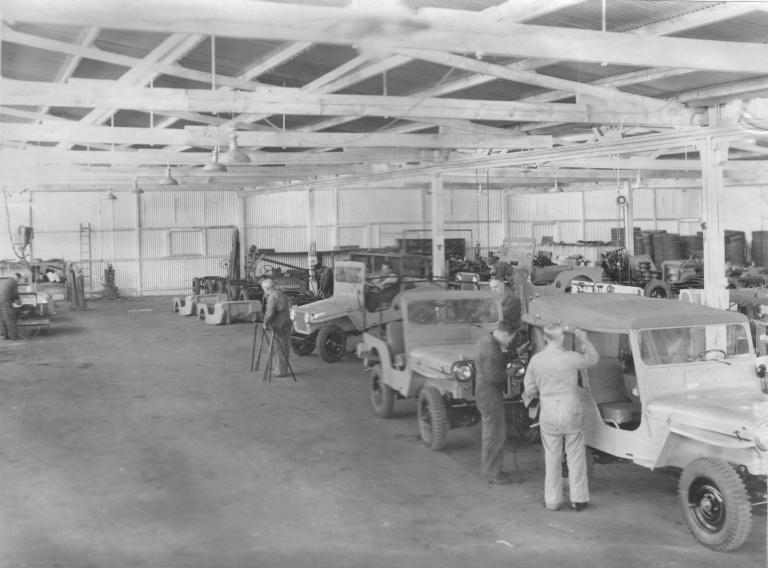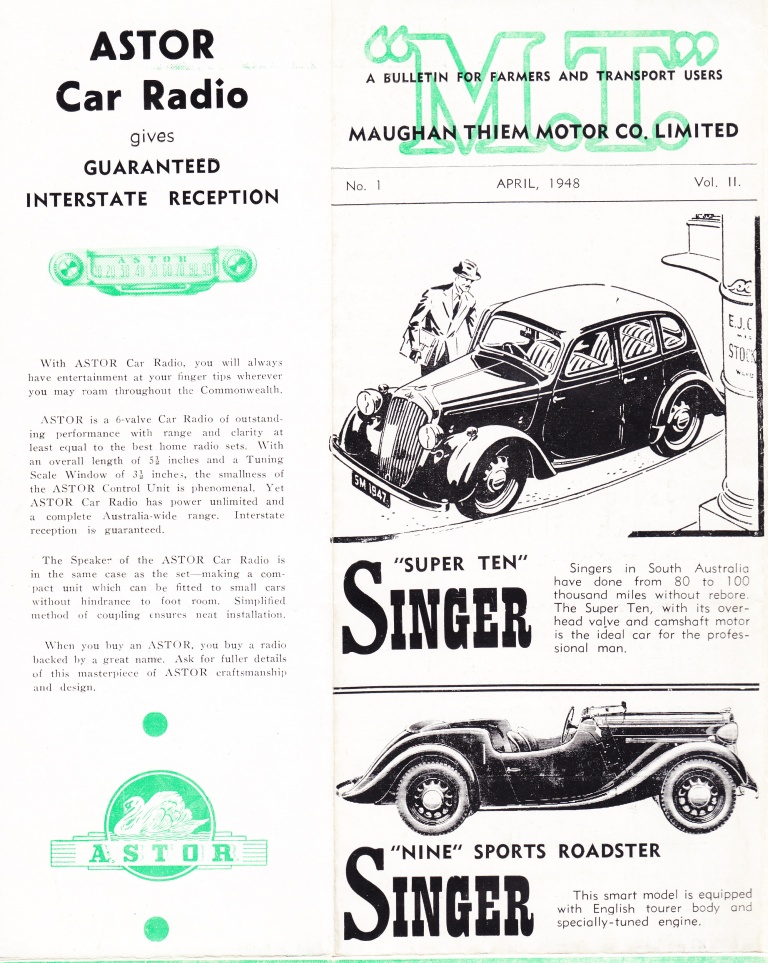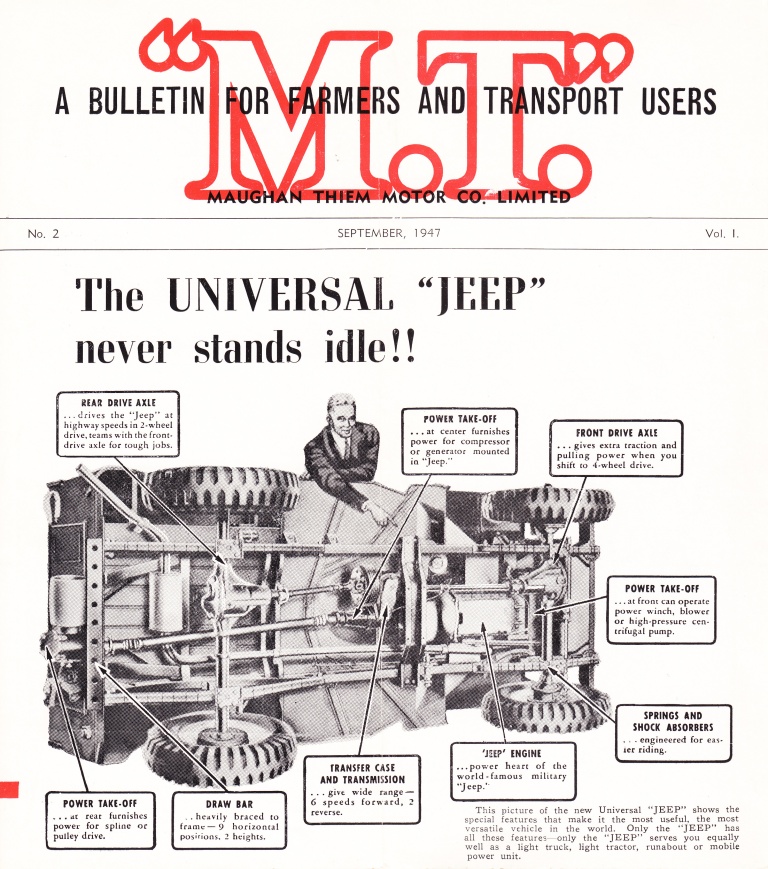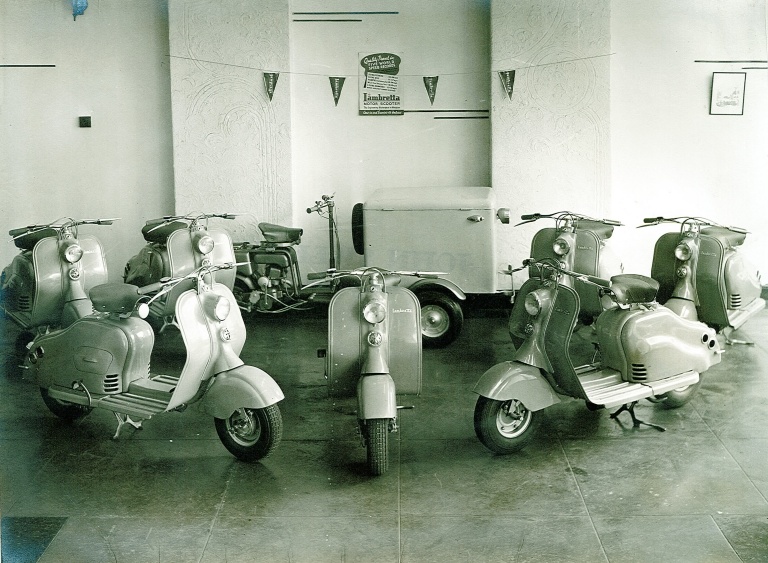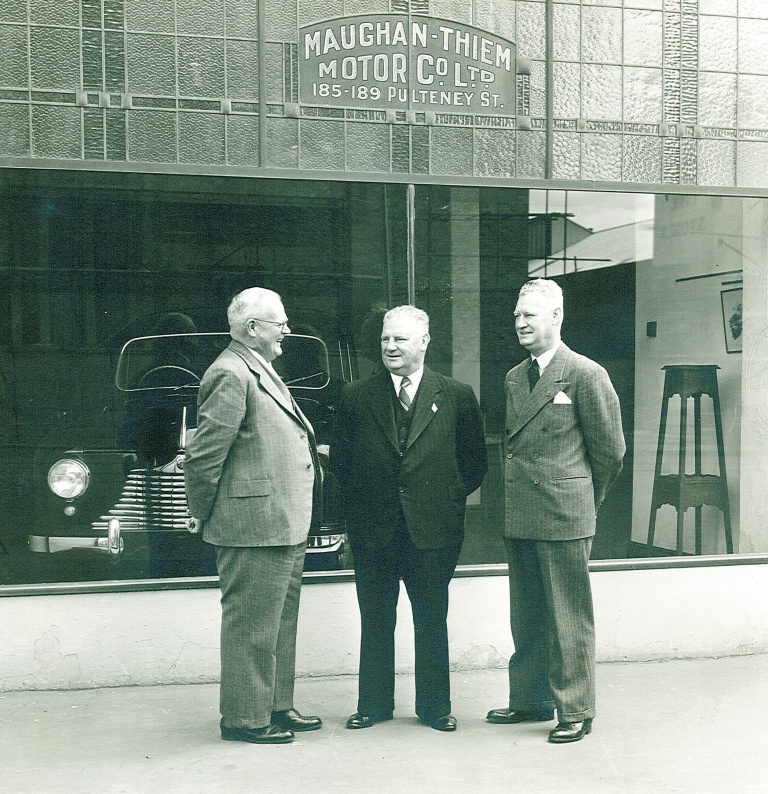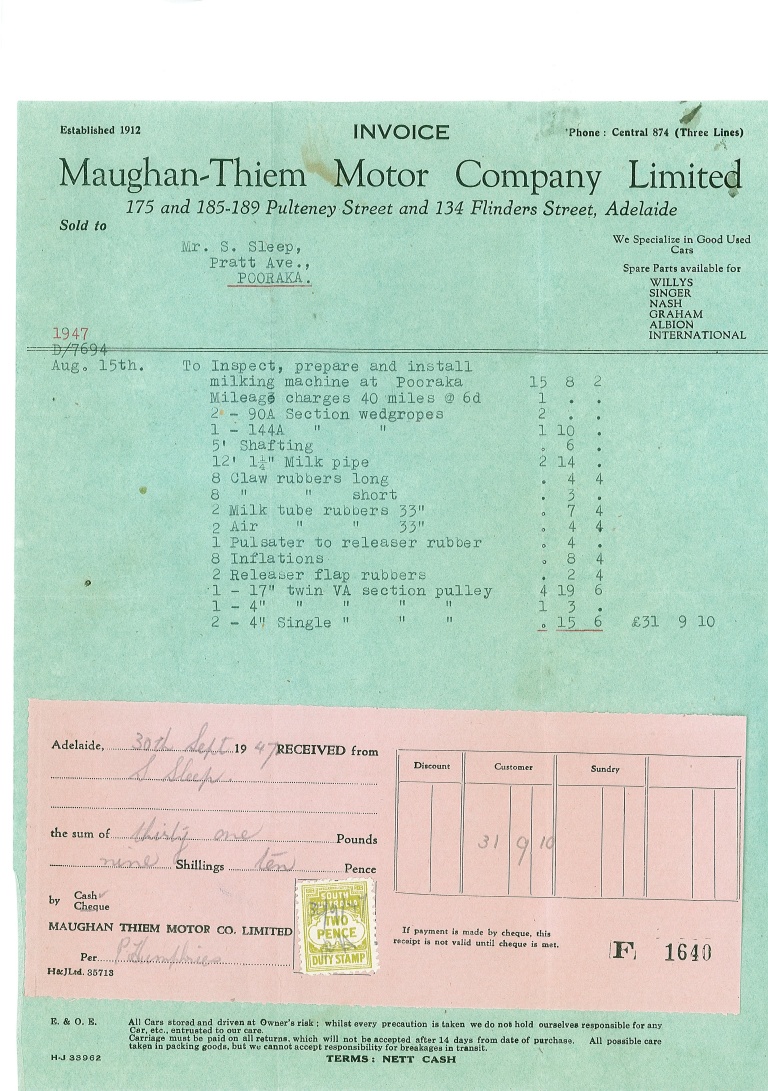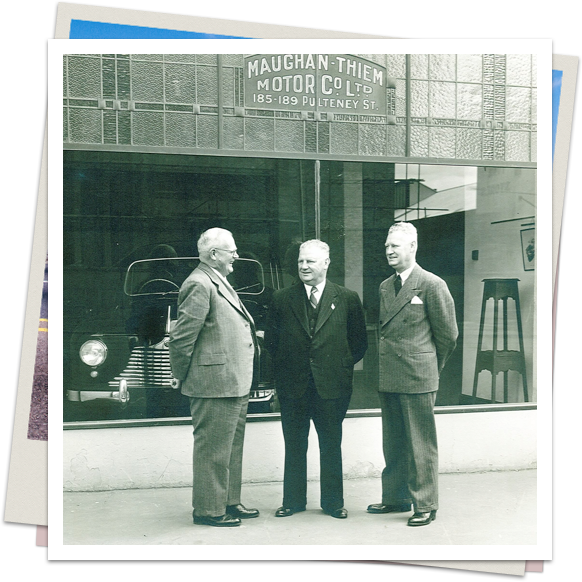
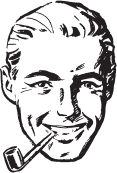
1935 - 1958
By the end of 1935 the management of the Maughan Thiem company could find in the firm's profit and loss accounts some hopes that the depression had been weathered, and an increasing profitability in the next few years confirmed these hopes.
By the end of 1935 the management of the Maughan Thiem company could find in the firm’s profit and loss accounts some hopes that the depression had been weathered, and an increasing profitability in the next few years confirmed these hopes. The firm set about staging its recovery after the depression once again on the recipe for success on which it had based its past achievements. It had in the past sought agencies for vehicles likely to attract good business, and as some had declined or proved unprofitable they had been replaced or supplemented by others. This was done again. By 1931 all the company’s eggs were in the Graham-Paige basket so far as new car business was concerned, and in that year only about five new cars were sold. Further agencies were clearly indicated.
The first agency secured at this time was for the Singer car, which made its initial appearance in Maughan Thiem’s books during the year ended 30 June 1932. It remained there for the following 25 years, only disappearing when Maughan Thiem took up the Ford franchise. The Singer proved to be a valuable asset to Maughan Thiem as one of a few agencies on which the firm thrived after the depression. For about seven years it was Maughan Thiem’s best selling line, while in some other years it did well and in others fell well behind other makes handled by the firm. The late 1940s and early 1950s appear to have been its best years.
Maughan Thiem, of course, did not introduce the Singer to South Australia. At the end of 1925 Maughan Thiem’s secretary Mr L.G. Rasch went into partnership with George Mason, and by March 1926 George Mason & Rasch Ltd was advertising as agent for the Singer Company Limited of Coventry and also, later, Birmingham. When later, in 1926, Mason and Rasch dissolved their partnership Rasch Motors Ltd of 69 Waymouth Street retained the Singer agency and continued to operate it until Maughan Thiem accepted it. For a while Rasch also handled the Austin, and in 1931 added the Rugby and the Durant to his business. In December 1933 he put his emphasis on the Continental products which came from an amalgamation of the Continental Engine Co and Durant Motors. He was obviously prepared to let Singer go. During the depression it had fared no better than other new cars, and in 1933 the odd one or two were sold each month. After the depression Maughan Thiem found a much readier market for this car, and consequently inherited from the company’s former secretary a lucrative agency.
About a year after Singer the Willys agency was added. The franchise had been held by Autocars of Flinders Street, but that firm closed down and Maughan Thiem took over Willys by August 1933. The Willys, like the Singer, remained with the firm until the Ford franchise and served Maughan Thiem well. In 1933 the Willys 77 came out in three models, the Roadster Tourer selling at £269, the Coupe at £285 and the Family Sedan at £299, and in each of the few months from August 1933 some six new cars were already being sold. As the post-depression recovery accelerated so did the sale of cars, and between 1934 and 1943 Willys headed Maughan Thiem’s new car sales and was a good seller in other years. After the war Willys had a further attraction. Surplus army stocks of the famous Willys Jeep became available to Willys distributors and Maughan Thiem was therefore able to reap the benefit, which the company did to good effect. Mr Hugh Payne travelled South Australia with the Jeep, setting up agencies and attending to their orders. Over one hundred of these army vehicles were taken, reconditioned and sold by Maughan Thiem in this way, and when the Jeep became a commercial vehicle the company continued to handle it. From the company records it appears that in all some 580 Jeeps were sold by the company between September 1946 and April 1958. Maughan Thiem staged its recovery from the depression on the Singer and the Willys, and later consolidated this with other very useful business lines.
Continue Reading
In addition to these two popular makes of motor car the company did some business in trucks. For a time during the 1930s a few Willys trucks were sold, mainly from about 1934 to 1936. In addition, during 1935 to 1938 the company sold a few trucks produced by Albion Commercial Motors of Glasgow. The Albion company was said to have been in business since 1901, when it produced its first commercial vehicle, and in June or July 1922 N.G. Cleveland & Co of Wakefield Street was appointed South Australian representative. The Albion was an expensive unit which was fully imported in chassis form, the body then being built locally. It was an excellent performer, and a few had bus bodies constructed for them; but it was in a price range which limited its market, and although Maughan Thiem exhibited and advertised it in 1938 not a large number was sold.
By 1937 the depression was just a memory, and the company found itself once again in need of additional space. More room was required to assemble the new cars handled by the company in increasing numbers. In 1937 Willys easily topped the list, as it did also in the following few years, but Singer too sold well and the Graham car had made a recovery and sales increased, and the occasional Albion truck was sold. Further, the company’s business was by no means limited to new car sales, important as these were rapidly becoming once again. The used car business was blossoming and the repairs and spare parts divisions drew an increasing amount of business, as gross income figures from the company’s profit and loss accounts demonstrate.
| Year Ended 30 June | Willys, Singer, Graham Sales £ | Used Car Sales £ | Repairs £ | General Sales £ |
| 1936 | 6,475 | 2,456 | 2,373 | 659 |
| 1937 | 12,826 | 3,502 | 3,304 | 919 |
| 1938 | 17,550 | 3,115 | 4,796 | 997 |
In February 1923 Maughan Thiem had gained tenancy of the premises at 185-9 Pulteney Street, which had become the company’s main showroom and registered office. A few doors down, at 175 Pulteney Street, further property now became available. For a while these premises had been occupied by Adelaide Motors, who had the agency for Fiat, Sunbeam and, later, Maudsley lorries. Freeman Motors were there later, until they moved to Grenfell Street in July 1929, and after that various other tenants followed in quick succession until Maughan Thiem was able to gain possession in about 1937. Company records are incomplete and the exact date cannot be ascertained, but in 1938 the South Australian Directory for the first time entered Maughan Thiem’s name against this address. Before the company expanded on to this site its workshop and spare parts division had been housed in the Flinders Street premises, and these were now relocated at 175 Pulteney Street. Mr Fred Maughan’s office was also moved there. It was conveniently connected with the company’s premises at 185-9 Pulteney Street and 134 Flinders Street through Naylor Street, to which all three properties had access from the rear. Over the years 175 Pulteney Street served the company in various ways, later housing other operations such as used car sales, lubrication, body repairs and painting, and so forth.
For assembling its new vehicles Maughan Thiem had for a time taken property at 700 Port Road Beverley, now occupied by the South Australian distributors of Mazda. Within a short time this property became too small for the purpose, and the company consequently bought a site which served it admirably for many years. This was on the corner of Orsmond and Adam Streets Hindmarsh. On 31 August 1937 the company paid £532:19:0 for freehold possession of the block, and a building for assembling vehicles was erected by the contractors Fox Ey and Thomas, to whom the final payment on completion of the work was made on the last day of 1937. The Hindmarsh property immediately came into full use for storing and assembling Willys and Singer cars, and later also Willys Jeeps, Nash cars and International products. In later years it also housed the major repair and service divisions and was used in other ways. Hindmarsh was a useful addition to the company’s premises, which by this time consisted of the enlarged Flinders Street premises, the imposing showrooms and registered office at 185-9 Pulteney Street, the workshop and spare parts section at 175 Pulteney Street, and the Hindmarsh property.
The bad days of the depression indeed seemed to have passed, not only for Maughan Thiem but also for the motor trade in general. Sales of new cars and commercial vehicles throughout Australia for the year ended 30 June 1936 increased over the previous year by 49 per cent, and in 1936 South Australia was once again the most motorised State with one vehicle per 8.8 inhabitants, ahead of Western Australia with one per 9.7 and the other States with even lower ratios. It seemed a good time for optimistic plans for further business expansion.
The new line of business on which Maughan Thiem embarked was the agency for the Nash car, which the company had by July 1938. Before then other dealers had distributed this make of car. Autocars Limited of Flinders Street had done so in the 1920s then Les Rasch, Maughan Thiem’s former secretary, entered the story once again when Rasch Motors took over the Nash agency until Maughan Thiem gained it. The Nash chassis was imported from America and the body was supplied by Richards body works which was later incorporated in the Chrysler works. It is recalled that one prototype Nash body was imported from America, and from this Richards made the templates for local production. Under Commonwealth tariff provisions the imported body could not be sold or used, and it was dumped in the Port River under the supervision of Customs authorities.
Maughan Thiem’s debut with the Nash coincided with the war years and sales were sluggish. After 1945 business became more encouraging, and in the 1947-8 financial year Nash was the company’s best seller. It sold well in other years but sales did not again match the success of that short time. It remained an important part of Maughan Thiem’s business until the Ford franchise was taken in 1958, in all a period of about twenty years.
Maughan Thiem shared with business in general the uncertainties and hardships of the years of the second world war. By and large business declined, and gross sales figures for 1945 were less than half of those for 1939. Due to a combination of circumstances the financial year which ended 30 June 1943 yielded very sound profits; but, apart from that year, company profitability declined steadily during the war. With the exception of Nash, which rose sharply in 1943, sales of new cars steadily declined. Used car sales peaked in 1943 and then dropped sharply, while the sale of parts increased moderately and income from repairs continued at an even level. For a few years some motor vehicles grew an ugly appendage at the rear, and the public gradually became accustomed to the sight of the charcoal-burning gas producers which some motorists bought as petrol rationing took its toll of available fuel. Maughan Thiem had its share of this trade, and from about 1941 to the end of the war the company supplied a gas producer made by Electrolux.
The transition to a peace-time economy in Australia brought its full share of hopes and frustrations. Government controls were gradually eased from manpower, commodities, wages and the money market, and there was in general an optimistic sense of relief that the dark war years were over and better times lay ahead. For a time, however, this optimism was tinged with uncertainty and conflict over what was seen by some as the threat of ‘creeping socialism’ and government control over banking and finance. The victory of Menzies’ Liberal and Country Party in the elections of December 1949 was seen by many as the end to these fears and as a green light to business expansion and prosperity. The new government had promised to put value back into the pound and to minimise government intervention in free enterprise. In February 1950 petrol rationing was removed and there was a scramble for service station sites and an orgy of building on them. The various petrol companies waged a battle with the additives which would improve their products and competition was increased by the appearance of the one-brand service station. A new golden age for the motor industry seemed to have dawned.
Hindsight has made it more obvious that the lifting of controls would lead to price rises which, in turn, would make it impossible to restore value to the pound. Inflation, with occasional periods of respite, became a constant feature of the economy, and in the March quarter of 1952 it reached the astronomical figure for Australia of 22.5 per cent. Nevertheless it was a period of full employment and rising wages. There was a huge backlog in housing, railways and other capital works and in the provision of peace-time consumer goods. If value was not restored to the pound it seemed nevertheless that there were plenty of additional pounds to buy what people wanted. In those days of material prosperity a constant flow of immigrants steadily expanded the home market for most consumer goods, including the motor car.
The profit and loss accounts of the Maughan Thiem company closely reflect the ups and downs of those post-war years. Profits for the year 1946 were more than four times those for the previous year, and until 1951 they continued to climb at a very steady rate. Then the effects of what came to be called the government’s ‘stop-go’ economic policy became apparent. This was the government effort to slow the economy down or to speed it up again in response to the need to balance overseas payments and to control inflation. In 1951 Fadden introduced his ‘horror budget’ which increased income tax by about ten per cent, and in the following years Maughan Thiem’s profits fell considerably. The credit squeeze of the ensuing period likewise had its adverse effects on trading and business. A supplementary budget in March 1956 increased taxes on cars and petrol as well as on other items, again to the detriment of the company’s trading. For a short time conditions improved and the year which ended 30 June 1960 produced quite substantial profits, but once again measures taken by the federal treasury took their tolI. In November 1960 a mini-budget restricted credit and increased sales tax on new cars and station waggons from 30 to 40 per cent. The Sydney Morning Herald saw it as a ‘panic budget’ designed to put private enterprise on its back, at least temporarily, and complained about the government’s fits and starts, ups and downs and twists and turns. Maughan Thiem’s annual report announced a loss which could ‘be traced back largely to the Government’s restriction of credit last November. Trading was buoyant up to that time.’ It was, continued the report, unfortunate that the opening of the new showroom and used car lot at Nailsworth coincided with the increase in sales tax and the credit squeeze. The reaction was not confined to Maughan Thiem’s directors, and in the election of December 1961 the government’s economic policy was rebuked by an electorate which returned the government with a majority of only one seat. As a result, in February 1962, income tax was cut by five per cent and sales tax on motor vehicles was reduced to 22½ per cent. Maughan Thiem’s annual report saw this as a turning point which improved operations and once again put trading on a profitable basis, although bad debts from the previous year or two still affected the company’s profitability.
In 1945, of course, all of this still lay in the future, and optimistic plans prevailed for a return to normal living. Those who had survived active service returned to civilian occupations, and peaceful reconstruction free from war-time restrictions was the order of the day. The Maughan Thiem company entered into the spirit of the times by securing another important agency. This was for International products.
Company profit and loss accounts first contained the item ‘International Sales’ in the year which ended 30 June 1944. In that year the modest sum of £794 was entered against this item, but in the following two years the amounts were £3,026 and £6,413, only exceeded by gross income from repairs and used car sales. From 1947 the single International entry in company accounts was replaced by individual entries for International trucks, machinery, repairs and, later, store sales, and for some years the range of International products, and service to them, were very profitable to the company. Indeed, the premises at 134 Flinders Street became Maughan Thiem’s International Sales and Service division and carried a display of trucks, tractors, machinery and spare parts. The company also issued from about this time a little annual publication, ‘M.T. A Bulletin for Farmers and Transport Users’, prominent in which were advertisements for such International Harvester products as Defender refrigerators, McCormick-Deering mowers, feed-grinders, fertiliser distributors, offset disc harrows, potato planters, Farmall tractors, hay balers, and model KB trucks. As was the case with the Willys Jeep, surplus army stocks of International trucks, mainly D and K series vehicles, also became available for a time to the company for reconditioning and sale as second-hand vehicles. These army supplies were released through the Arrow motor company, complete with the spare parts necessary to recondition them. Mr Hugh Payne recalls that when he was demobilised from the army in 1946 he was put in charge of the spare parts division of the International agency in general, until this was taken over by Mr Ray Hanrahan. Until about 1957 all the company’s International business did well, with occasional high and low periods. Truck sales were declining slightly by 1956, machinery sales reached their peak in 1951 and 1952 and dropped off sharply after those years, store sales remained reasonably constant, and the repair department peaked from 1951 to 1954.
A few years after taking up the International agency Maughan Thiem added two further lines of business which were of slighter financial value. The first was the McGrath trailer, in which the company traded from about 1947 to 1955. Two models were offered. The ‘Busybody’ was a twowheeled trailer, and the four-wheeled ‘Baby Quin’ was advertised as suitable for use as a flat platform, a hay rack, a grain box, a stake rack, and a live stock float. Sales of the trailer were best in 1949 and 1950. The second line of business was the Lambretta motor scooter, which was on the company’s books from about 1950 to 1953 and sold reasonably well during that time.
Before all its various agencies were dropped in favour of the Ford franchise, Maughan Thiem moved into a further line of motor vehicle business. In 1954 the company started to sell products of the Rootes group, and in 1957 a Main Dealer Agreement was signed between Rootes (Australia) Limited of Port Melbourne and the Maughan Thiem Motor Company. This entitled the company to retail the Rootes Group range of vehicles and service parts anywhere in Australia and to supply them to other Rootes dealers in the metropolitan area. For a year or two Maughan Thiem found that the Humber, Hillman, Sunbeam and Commer vehicles sold well, but shortly after taking the Rootes franchise the company changed over to Ford and the Rootes dealership was dropped.
In 1937 the company had extended its premises to include 175 Pulteney Street and Orsmond Street Hindmarsh. Since then the depression and war years had not encouraged any further expansion of this sort and the company had to be content with its existing space for some eighteen years. However, by 1955 Maughan Thiem was once again inclined to spread its wings and look for additional territory.
In August 1955 the company paid a deposit on a piece of land in Halifax Street for development as a parking station, and over the following months the balance was paid off and the property was levelled and fenced. It was soon realised that this was an unrealistic project, perhaps undertaken in a moment of euphoria after the many years of depression and war. The parking station was opened late in February 1958, but three months later it was put on the market. The city council eventually bought it for use as a bitumen plant. In June 1958 the company bought another property at 88 Main North Road Prospect for possible development as a showroom and used car lot. This property was also sold shortly afterwards, but only because premises better suited for the purpose were found further out on Main North Road at Nailsworth. The company subsequently operated for many years at Nailsworth, as will appear in the following chapter. The purchase of the block at Prospect in fact became the prelude to substantial extensions undertaken during the boom years of the 1960s.
An internal business reorganisation was also effected by the company in October 1956, basically for auditing and taxation purposes. The Maughan Thiem Motor Company established three fully-owned subsidiary companies. These were Maughan Thiem Motor Sales Limited, Maughan Thiem Truck Sales Limited, and Maughan Thiem Service Limited. This administrative adjustment, of course, had no bearing on the public conduct of the firm’s trading and business.
The public was left in no doubt about the company’s business. Above the entrance to the main showrooms and registered office at 185-9 Pulteney Street was a large revolving Neon sign, said to be the first of its kind in Adelaide. The names of the company’s agencies were illuminated, and prospective buyers were advised in this way that Nash, Willys, Singer, Albion and International vehicles and products were on sale at that address. These were the names on which Maughan Thiem built its recovery after the depression and continued to grow in the postwar years.
